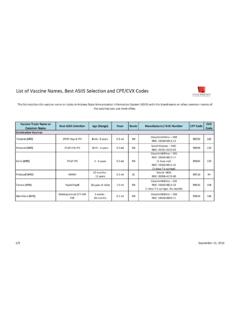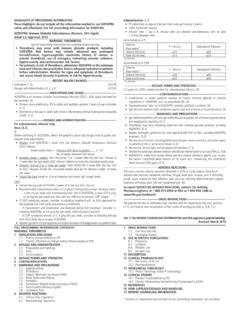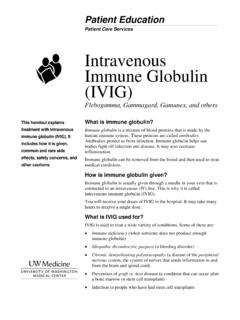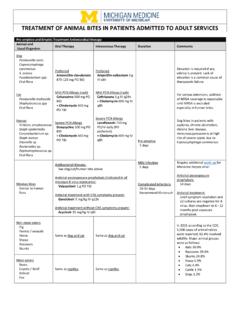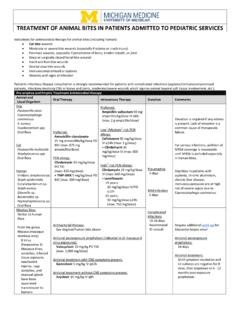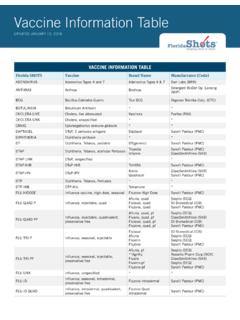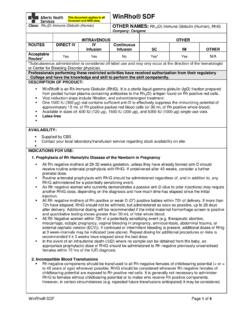Transcription of A. Patricia Wodi, MD and Valerie Morelli, BA Immunology ...
1 Principles of Vaccination11 Immunology and Vaccine-Preventable DiseasesImmunology is a complicated subject, and a detailed discussion of it is beyond the scope of this text. However, an understanding of the basic function of the immune system is useful in order to understand both how vaccines work and the basis of recommendations for their use. The description that follows is simplified. Many excellent Immunology textbooks are available to provide additional detail. Immunity is the ability of the human body to tolerate the presence of material indigenous to the body ( self ), and to eliminate foreign ( nonself ) material. This discriminatory ability provides protection from infectious disease, since most microbes are identified as foreign by the immune system. Immunity to a microbe is usually indicated by the presence of antibody to that organism. Immunity is generally specific to a single organism or group of closely related organisms.
2 There are two basic mechanisms for acquiring immunity, active and passive. Active immunity is protection that is produced by the person s own immune system. This type of immunity usually lasts for many years, often during a lifetime. Passive immunity is protection by products produced by an animal or human and transferred to another human , usually by injection. Passive immunity often provides effective protection, but this protection wanes (disappears) with time, usually within a few weeks or months. The immune system is a complex system of interacting cells whose primary purpose is to identify foreign ( nonself ) substances referred to as antigens. Antigens can be either live (such as viruses and bacteria) or inactivated. The immune system develops a defense against the antigen. This defense is known as the immune response and usually involves the production of protein molecules by B lymphocytes, called antibodies (or immunoglobulins), and of specific cells, including T-lymphocytes (also known as cell-mediated immunity) whose purpose is to facilitate the elimination of foreign substances.
3 The most effective immune responses are generally produced in response to a live antigen. However, an antigen does not necessarily have to be alive, as occurs with infection with a virus or bacterium, to produce an immune response. Some proteins, such as hepatitis B surface antigen, are easily recognized by the immune system. Other material, such as polysaccharide (long chains of sugar molecules that make up the cell wall of certain bacteria) are less effective antigens, and the immune response may not provide as good protection. Immunity Self vs. nonself Protection from infectious disease Usually indicated by the presence of antibody Generally specific to a single organismActive Immunity Protection produced by the person s own immune system Often lifetime Passive Immunity Protection transferred from another animal or human Effective protection that wanes with timeAntigen A live ( , viruses and bacteria) or inactivated substance capable of producing an immune responseAntibody Protein molecules (immunoglobulins) produced by B lymphocytes to help eliminate an antigen 2 Principles of Vaccination 1 Passive ImmunityPassive immunity is the transfer of antibody produced by one human or other animal to another.
4 Passive immunity provides protection against some infections, but this protection is temporary. The antibodies will degrade during a period of weeks to months, and the recipient will no longer be protected. The most common form of passive immunity is that which an infant receives from its mother. Antibodies are transported across the placenta during the last 1 2 months of pregnancy. As a result, a full-term infant will have the same antibodies as its mother. These antibodies will protect the infant from certain diseases for up to a year. Protection is better against some diseases ( , measles, rubella, tetanus) than others ( , polio, pertussis).Many types of blood products contain antibody. Some products ( , washed or reconstituted red blood cells) contain a relatively small amount of antibody, and some ( , intravenous immune globulin and plasma products) contain a large amount. In addition to blood products used for transfusion ( , whole blood, red cells, and platelets) there are three major sources of antibody used in human medicine.
5 These are homologous pooled human antibody, homologous human hyperimmune globulin , and heterologous hyperimmune serum. Homologous pooled human antibody is also known as immune globulin . It is produced by combining (pooling) the IgG antibody fraction from thousands of adult donors in the United States. Because it comes from many different donors, it contains antibody to many different antigens. It is used primarily for postexposure prophylaxis for hepatitis A and measles and treatment of certain congenital immuno- globulin deficiencies. Homologous human hyperimmune globulins are antibody products that contain high titers of specific antibody. These products are made from the donated plasma of humans with high levels of the antibody of interest. However, since hyperimmune globulins are from humans, they also contain other antibodies in lesser quantities. Hyperimmune globulins are used for postexposure prophylaxis for several diseases, including hepatitis B, rabies, tetanus, and varicella.
6 Heterologous hyperimmune serum is also known as antitoxin. This product is produced in animals, usually horses (equine), and contains antibodies against only one antigen. In the United States, antitoxin is available for treatment of botulism and diphtheria. A problem with this product is serum sickness, an immune reaction to the horse protein. Passive Immunity Transfer of antibody produced by one human or other animal to another Temporary protection Transplacental most important source in infancySources of Passive Immunity Many types of blood or blood products Homologous pooled human antibody ( immune globulin ) Homologous human hyperimmune globulin Heterologous hyperimmune serum (antitoxin)Principles of Vaccination31 immune globulin from human sources is polyclonal; it contains many different kinds of antibodies. In the 1970s, techniques were developed to isolate and immortalize (cause to grow indefinitely) single B cells, which led to the development of monoclonal antibody products.
7 Monoclonal antibody is produced from a single clone of B cells, so these products contain antibody to only one antigen or closely related group of antigens. Monoclonal antibody products have many applications, including the diagnosis of certain types of cancer (colorectal, prostate, ovarian, breast), treatment of cancer (B-cell chronic lymphocytic leukemia, non-Hodgkin lymphoma), prevention of transplant rejection, and treatment of autoimmune diseases (Crohn s disease, rheumatoid arthritis) and infectious diseases. A monoclonal antibody product is available for the prevention of respiratory syncytial virus (RSV) infection. It is called palivizumab (Synagis). Palivizumab is a humanized monoclonal antibody specific for RSV. While certain antibody products like immune globulins interfere with live-virus vaccines, monoclonal antibody products specific to one, non-vaccine microbe do not interfere with live vaccines. Since palivizumab does not contain any other antibody except RSV antibody, it will not interfere with the response to a live virus vaccine.
8 Active ImmunityActive immunity is stimulation of the immune system to produce antigen-specific humoral (antibody) and cellular immunity. Unlike passive immunity, which is temporary, active immunity usually lasts for many years, often for a lifetime. One way to acquire active immunity is to survive infection with the disease-causing form of the organism. While exceptions (like malaria) exist, in general, once persons recover from infectious diseases, they will have lifelong immunity to that disease. The persistence of protection for many years after the infection is known as immunologic memory. Following exposure of the immune system to an antigen, certain cells (memory B cells) continue to circulate in the blood (and also reside in the bone marrow) for many years. Upon reexposure to the antigen, these memory cells begin to replicate and produce antibody very rapidly to reestablish protection. Another way to produce active immunity is by vaccination.
9 Vaccines interact with the immune system and often produce an immune response similar to that produced by the natural infection, but they do not subject the recipient to the disease and its potential complications. Many vaccines also produce immunologic memory similar to that acquired by having the natural Antibody Derived from a single type, or clone, of antibody-producing cells (B cells) Antibody is specific to a single antigen or closely related group of antigens Used for diagnosis and therapy of certain cancers and autoimmune and infectious diseases, as well as prevention of transplant rejectionAntibody for Prevention of RSV Palivizumab (Synagis) monoclonal contains only RSV antibody will not interfere with the response to a live-virus vaccine Active Immunity immune system produces antigen-specific humoral and cellular immunity Lasts for many years, often lifetime Sources infection with disease-causing form of organism vaccination Vaccination Active immunity produced by vaccine Immunity and immunologic memory similar to natural infection but without risk of disease4 Principles of Vaccination 1 Many factors may influence the immune response to vaccination.
10 These include the presence of maternal antibody, nature and dose of antigen, route of administra-tion, and the presence of an adjuvant ( , aluminum-containing material added to improve the immunogenicity of the vaccine). Host factors such as age, nutritional factors, genetics, and coexisting disease, may also affect the response. Classification of VaccinesThere are two basic types of vaccines: live attenuated and inactivated. The characteristics of live and inactivated vaccines are different, and these characteristics determine how the vaccine is used. Live attenuated vaccines are produced by modifying a disease-producing ( wild ) virus or bacterium in a laboratory. The resulting vaccine organism retains the ability to replicate (grow) and produce immunity, but usually does not cause illness. The majority of live attenuated vaccines available in the United States contain live viruses. However, two live attenuated bacterial vaccines are available in the United States (Ty21a and BCG).










